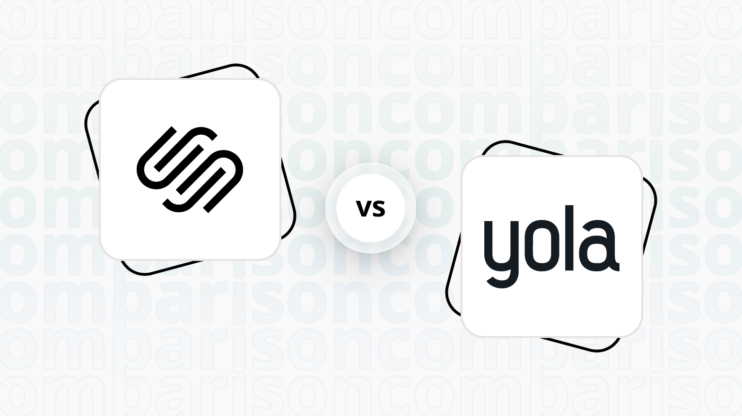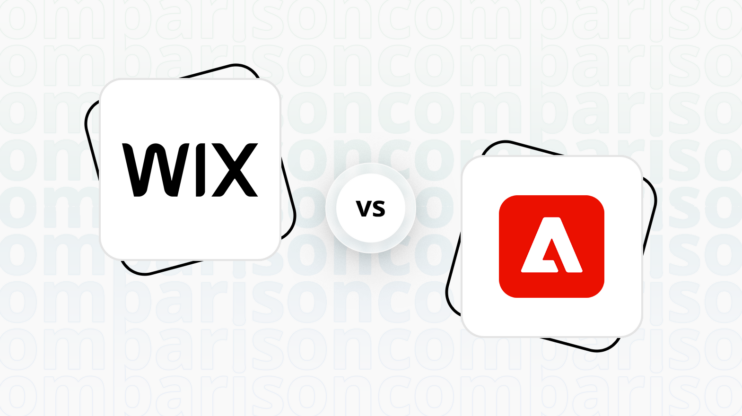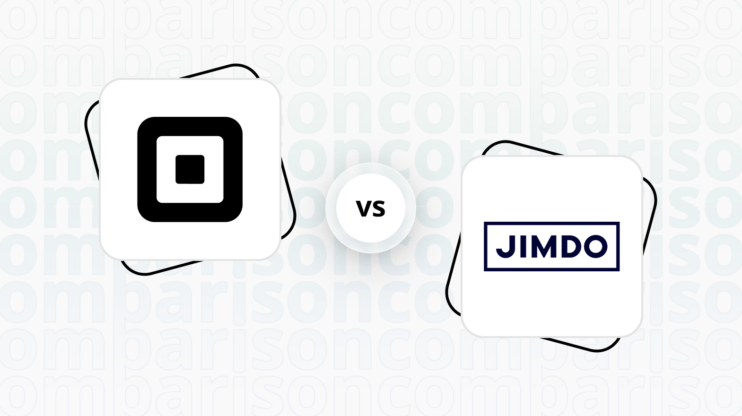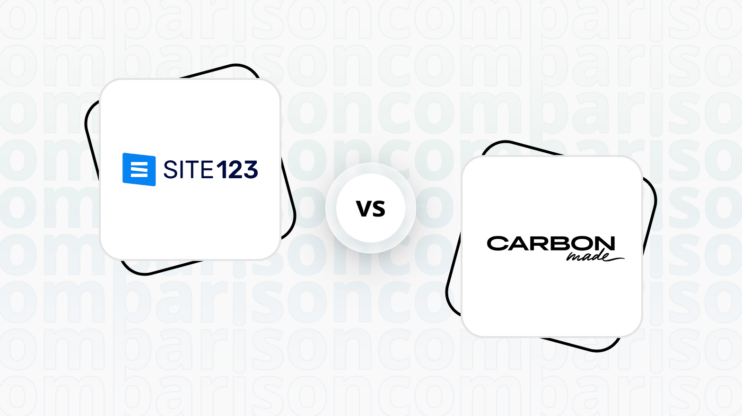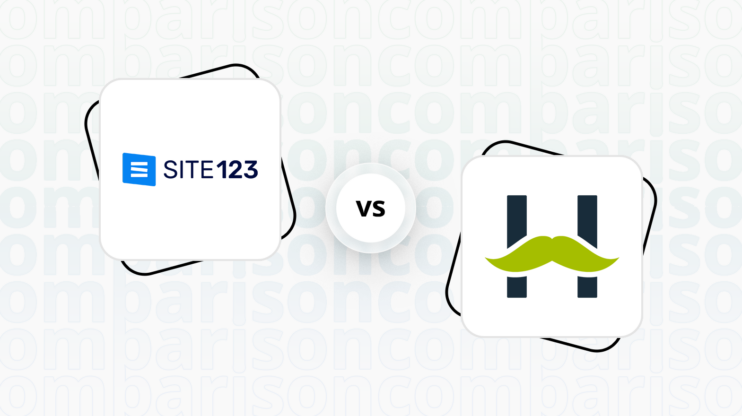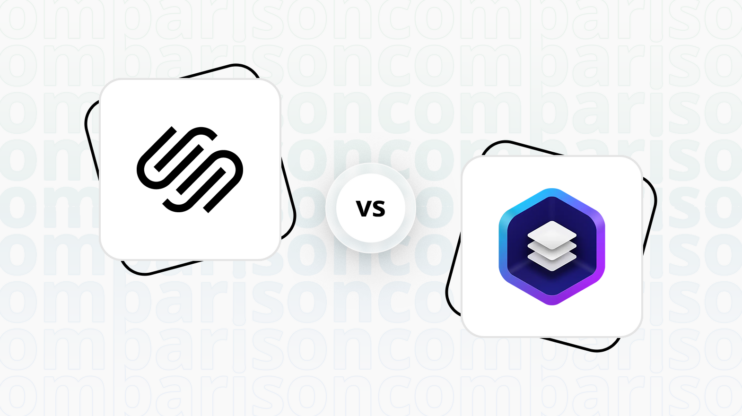Final verdict
Webflow and Adobe Commerce(ex Magento) both offer powerful platforms, but they cater to different user needs and expertise levels.
-
Webflow (Overall Grade: 7.9/10)
excels in providing a user-friendly interface with robust design tools, making it ideal for professional designers and developers. It offers a comprehensive solution for creating custom, responsive websites without extensive coding knowledge. Webflow’s strengths lie in its design functionalities, ease of use, and website speed optimization. It is a great choice for users who prioritize design flexibility and a visually intuitive interface. -
Adobe Commerce(ex Magento) (Overall Grade: 6.9/10)
is a versatile commerce platform suitable for both B2B and B2C businesses. It offers extensive ecommerce features, AI-driven personalization, and scalability with cloud-native solutions. Adobe Commerce is ideal for larger businesses that require advanced customization and integration capabilities. While it may have a steeper learning curve, its robust ecommerce tools and comprehensive marketing features make it a powerful platform for businesses aiming to scale and optimize their online stores.

|

|
|
|---|---|---|
|
Design functionalities & templates |
8.6 |
6.7 |
|
Ease of use |
7.5 |
5.4 |
|
Ecommerce |
8.5 |
9.4 |
|
Website Editors |
9.0 |
7.8 |
|
Product testing options |
6.3 |
3.9 |
|
Price |
8.0 |
5.8 |
|
Hosting quality |
8.9 |
8.1 |
|
Website speed optimization |
8.1 |
6.6 |
|
Plugins/extensions and integrations |
5.5 |
9.1 |
|
Marketing features |
7.8 |
8.1 |
|
Customer support |
8.3 |
8.3 |
|
Website security |
7.8 |
8.4 |
|
AI capabilities |
8.3 |
7.7 |
|
User Management |
8.3 |
8.0 |
| Overall |
7.9 |
6.9 |
Best for ecommerce
 8.5
8.5
 9.4
9.4
Verdict
: Adobe Commerce (ex Magento) is the superior choice for large-scale and highly customizable ecommerce solutions, while Webflow is excellent for designers seeking a balance between design flexibility and ecommerce functionality.
-
Webflow
: Webflow is a robust platform for creating online stores, offering comprehensive ecommerce features such as easy store creation without coding, extensive customization options, product management with variations, inventory tracking, integration with major payment gateways, automated shipping calculations, tax configuration, and marketing tools like abandoned cart recovery and email marketing. However, when comparing Webflow vs Adobe Commerce(ex Magento), Webflow may not match the scalability and advanced ecommerce capabilities of Adobe Commerce. -
Adobe Commerce (ex Magento)
: Adobe Commerce is a versatile commerce platform suitable for both B2B and B2C businesses, offering AI-driven personalization, support for multiple brands and markets, developer tools for customization, and scalability with cloud-native solutions. It includes features like store fulfillment, PWA studio, customer segmentation, and business intelligence tools. Its cloud delivery ensures security and PCI compliance, and it seamlessly integrates with third-party applications and services. Adobe Commerce’s extensive ecommerce capabilities make it a top choice for businesses looking for a highly customizable and scalable solution.
Best for informational & business websites
 8.6
8.6
 7.4
7.4
Verdict
: Webflow is the superior choice for creating informational and business websites, thanks to its powerful design tools and user-friendly interface. Adobe Commerce(ex Magento) is more suited for complex ecommerce needs but can still be used for informational sites with some effort.
-
Webflow
: Scoring 8.6, Webflow excels in creating visually appealing and responsive informational websites. Its robust design functionalities and templates, combined with an intuitive visual interface, make it ideal for professional designers and developers. Webflow’s managed hosting and focus on website speed optimization further enhance its suitability for business websites. When comparing Webflow vs Adobe Commerce(ex Magento), Webflow stands out for its ease of use and design flexibility. -
Adobe Commerce(ex Magento)
: With a score of 7.4, Adobe Commerce(ex Magento) is a versatile platform that offers extensive customization and scalability. While it is primarily designed for ecommerce, it can be adapted for informational websites. However, its complexity and focus on ecommerce features may pose challenges for users without technical expertise. Adobe Commerce(ex Magento) offers robust security and a wide range of plugins and integrations, making it a powerful but more complex option for business websites.
Detailed comparison
Design functionalities & templates
Design FunctionalitiesRepresents how well each platform allows for creative design and customization of websites.Score Components:
- Template Variety (30%): Range and quality of design templates.
- Customization (30%): Flexibility and options for design alterations.
- User Interface (20%): Ease and intuitiveness of the design process.
- Responsiveness (10%): Adaptability to different devices and screen sizes.
- Innovation (10%): Unique design features and tools.
 8.6
8.6
 6.7
6.7
🏆
Winner: Webflow.
With a score of 8.6, Webflow outperforms Adobe Commerce(ex Magento) in terms of design functionalities and templates.
Webflow delivers a robust design experience with a diverse range of template and customization options. Boasting over 1000 pre-built templates covering various industries and website types, including free and premium options, Webflow ensures a constantly evolving library for users.
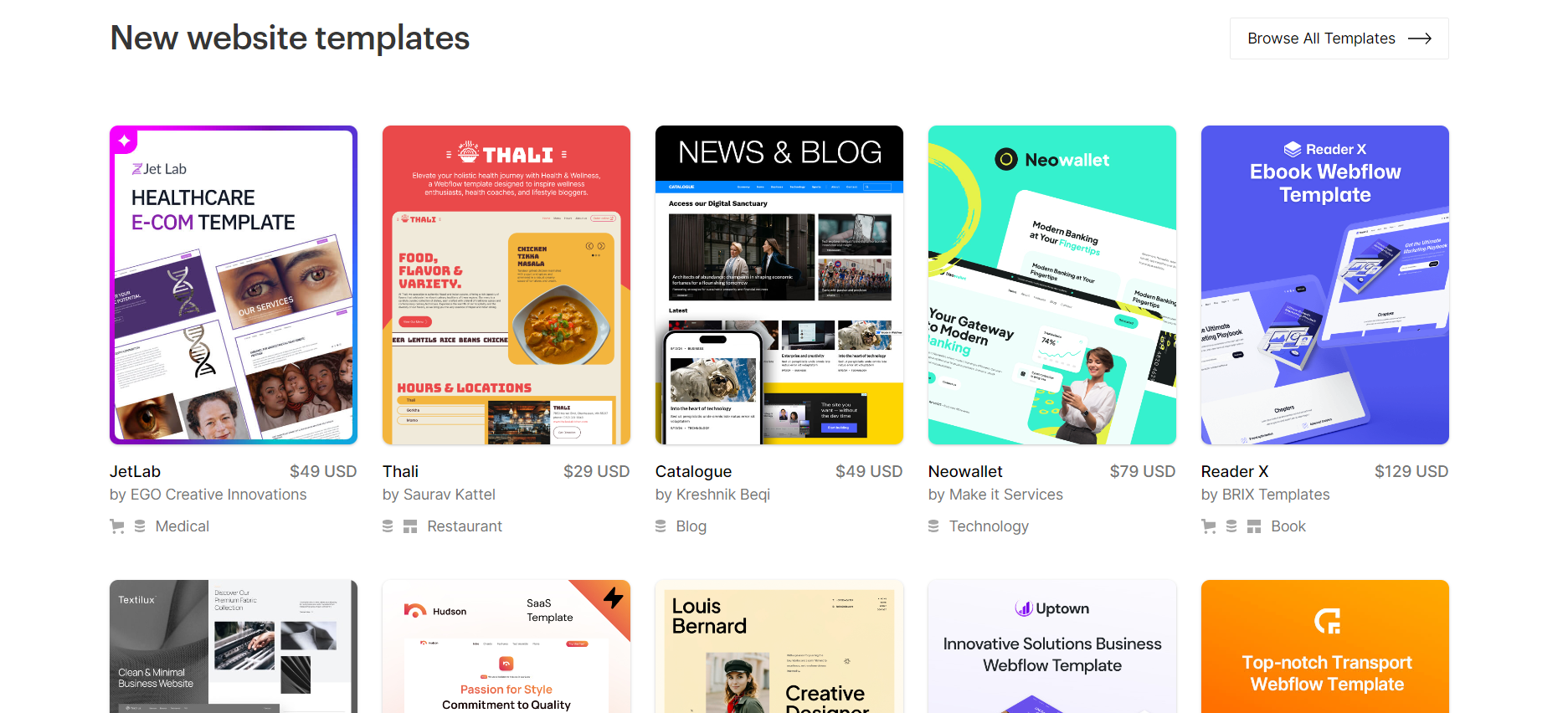
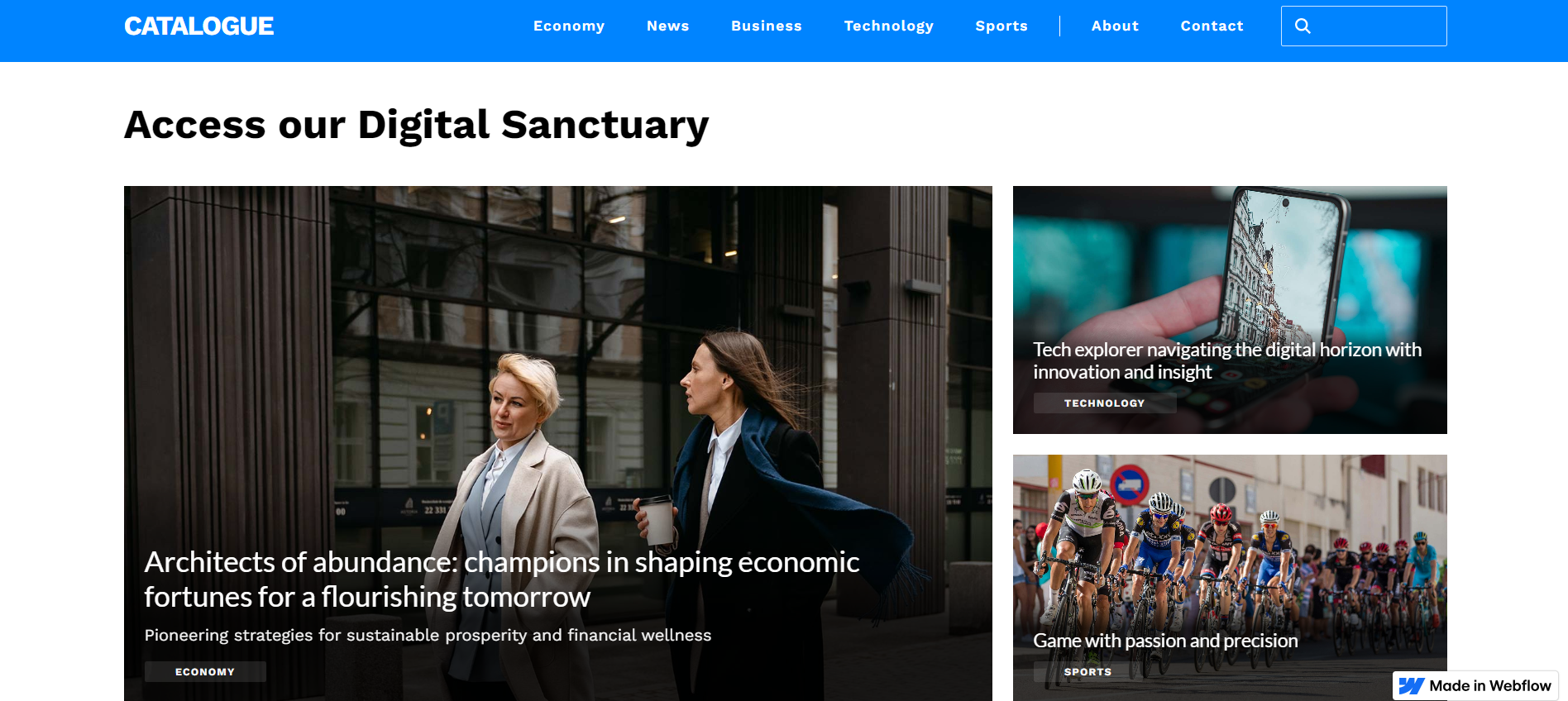
On the other hand, Adobe Commerce, formerly Magento, prioritizes flexibility over pre-built templates. While it offers a limited selection of base themes, users can access third-party themes for customization.
Adobe Commerce(ex Magento) Themes
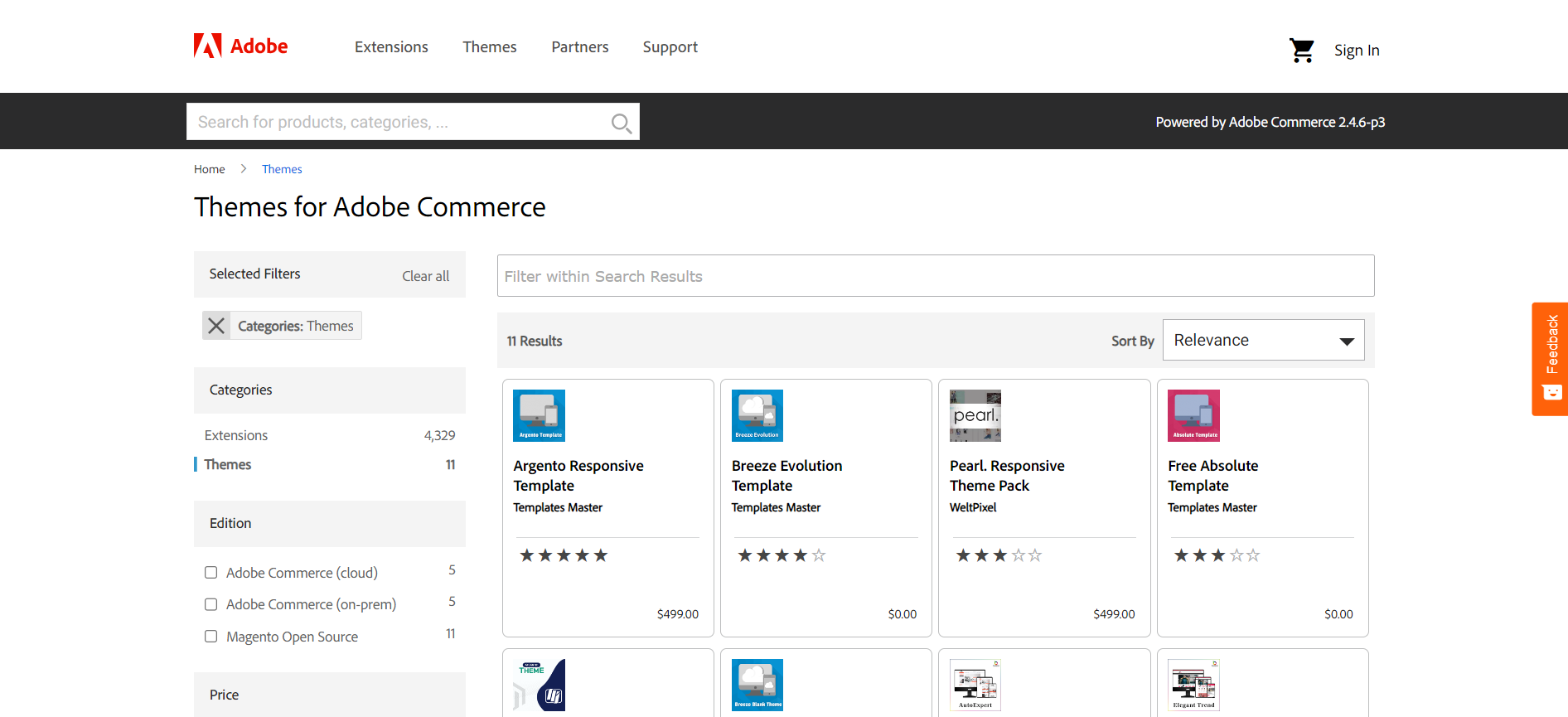
Get a head start on website creation with AI
Create a custom website tailored to your business needs 10X faster with 10Web AI Website Builder!
Ease of use
Ease of useReflects the platform’s overall user-friendliness.Score
Components:
- Learning curve (40%): Quickness and ease of getting started.
- Interface design (30%): Simplicity and intuitiveness of layout.
- User guidance (20%): Quality of tutorials and support.
- Flexibility (10%): Adaptability to various user skills.
 7.5
7.5
 5.4
5.4
🏆 Winner: Webflow
. Scoring 7.5, Webflow is user-friendly for experienced designers and developers, offering a visually intuitive interface with drag-and-drop features. Adobe Commerce(ex Magento), with a score of 5.4, offers high customization capabilities and scalability but its complexity can pose challenges for beginners without technical expertise.
Learning Resources
🏆 Winner: Tie
. Both Webflow and Adobe Commerce(ex Magento) offer a comprehensive set of learning resources. Webflow University and Adobe Digital Learning Services provide diverse courses and tutorials covering fundamental to advanced aspects of their respective platforms.
For ecommerce
EcommerceMeasures the platform’s effectiveness in supporting online business activities.Score Components:
- Ecommerce themes and templates (20%): Variety and design of templates.
- Product management (25%): Ease of managing and organizing products.
- Payment options (25%): Variety and convenience of payment methods.
- Ecommerce features (20%): Features for managing an ecommerce store.
- Integration (10%): Compatibility with external e-commerce tools and services.
 8.5
8.5
 9.4
9.4
Adobe Commerce (ex Magento) scores higher in the ecommerce sector with a score of 9.4 compared to Webflow’s 8.5. Adobe Commerce is a versatile commerce platform suitable for both B2B and B2C businesses, offering AI-driven personalization, supports multiple brands and markets, provides developer tools for customization, and ensures scalability with cloud-native solutions. On the other hand, Webflow is a robust platform for creating online stores, offering comprehensive ecommerce features such as easy store creation without coding, extensive customization options, product management with variations, inventory tracking, integration with major payment gateways, automated shipping calculations, tax configuration, and marketing tools like abandoned cart recovery and email marketing.

|

|
|
|---|---|---|
|
Ecommerce themes and templates |
7.5 |
7.5 |
|
Product page customization |
8.3 |
9.0 |
|
Payment processing and commissions |
7.8 |
7.8 |
|
POS capabilities |
6.5 |
7.0 |
|
Payment gateways |
8.0 |
8.5 |
|
Product numbers |
7.0 |
7.5 |
|
Additional ecommerce features |
7.9 |
8.0 |
Webflow ecommerce features:
- Checkout and Payment Processing with Stripe, PayPal, etc.
- Marketing and Promotions
- Tax and Shipping calculations
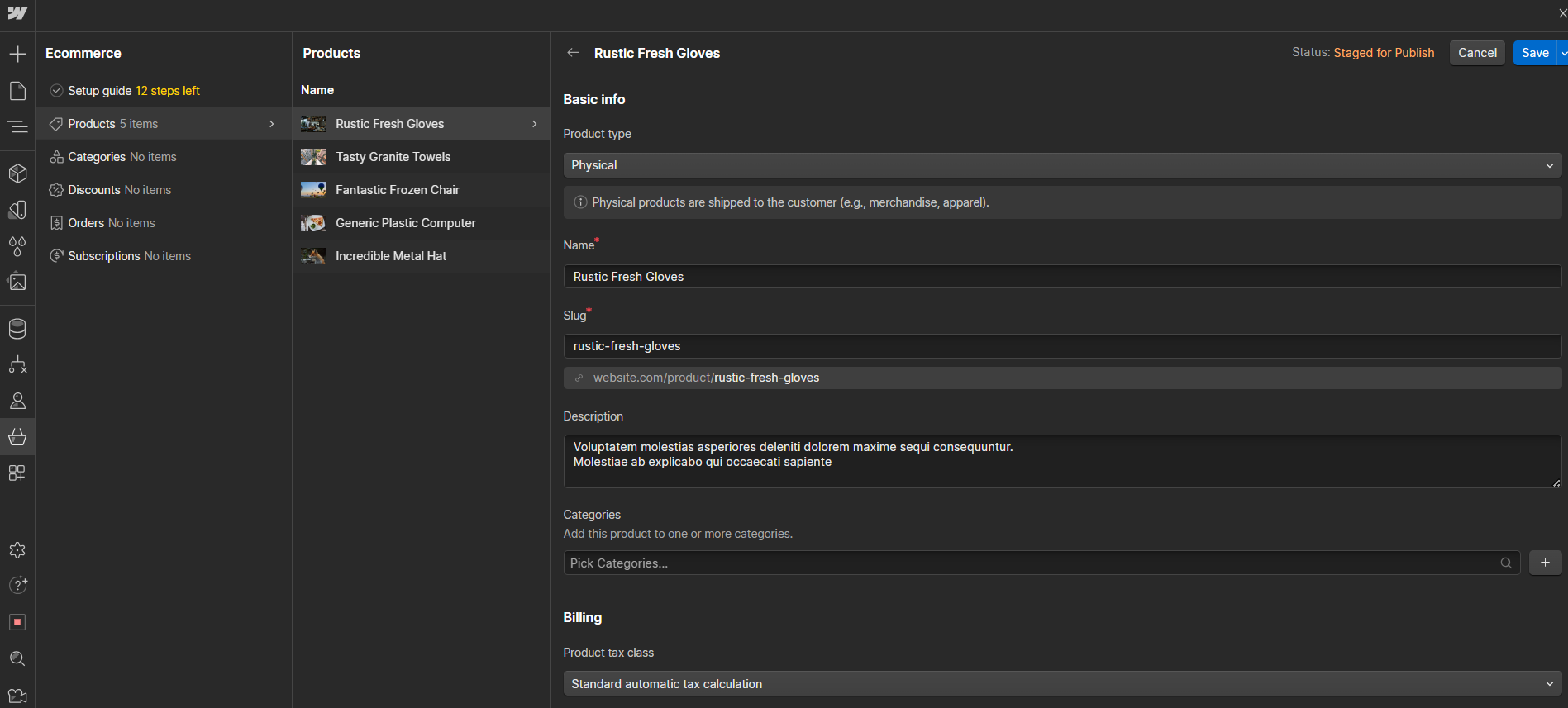
Adobe Commerce(ex Magento) ecommerce features:
- Product and Inventory Management
- Order Management
- Customer Management
- Marketing and Promotions
- Payment Processing
- Multi-Channel Commerce
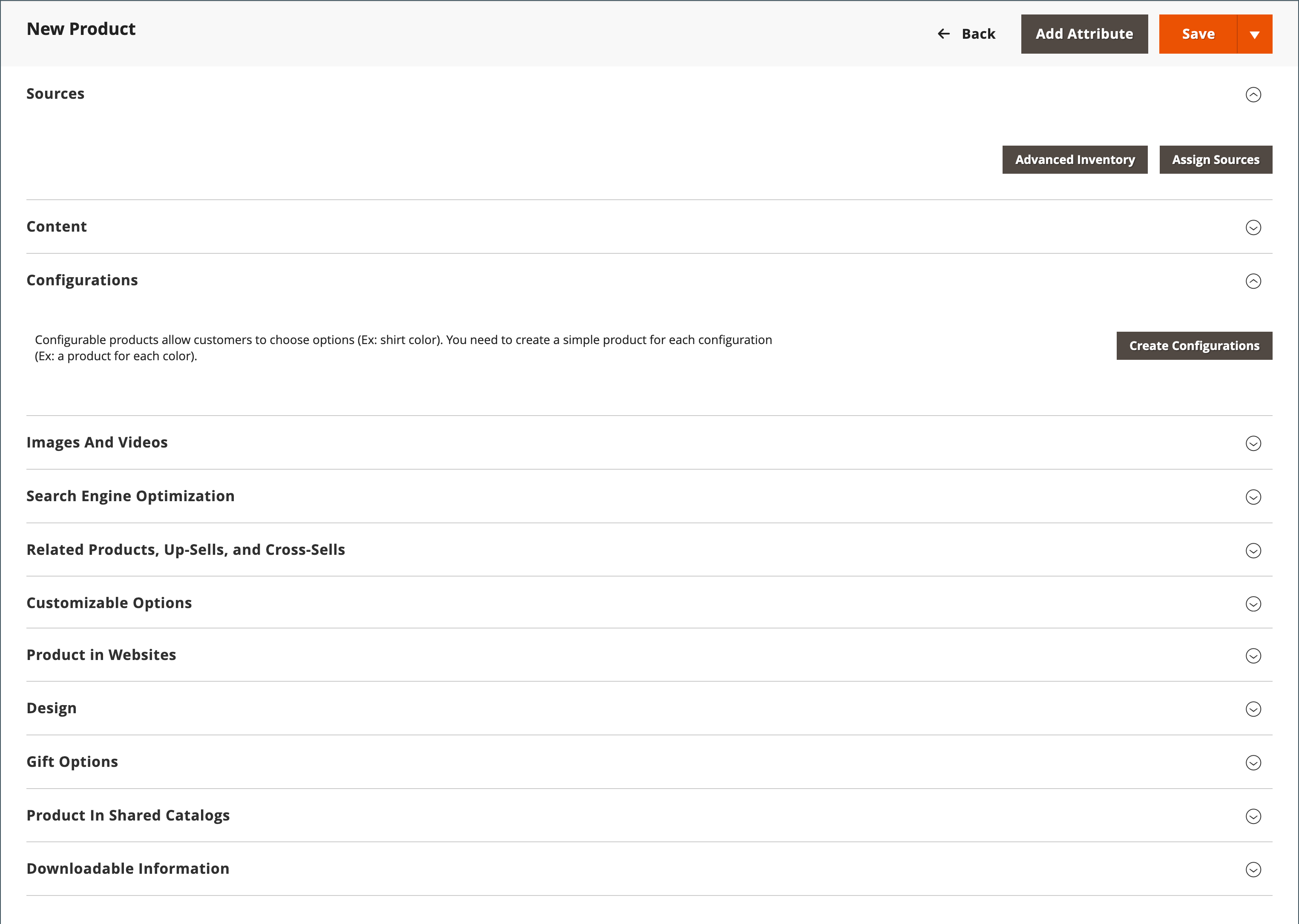
Ecommerce themes & templates
Webflow offers a diverse range of ecommerce themes and templates designed to cater to various types of online stores, from fashion and technology to artisan crafts and children’s products. Each template comes equipped with built-in ecommerce functionality, allowing you to easily add products and manage your store without the need for coding. Adobe Commerce, powered by Magento, offers a comprehensive ecosystem for ecommerce themes and templates, enabling businesses to customize their online stores to meet specific branding and functionality requirements. Themes in Adobe Commerce serve as the visual and structural framework for online stores, incorporating layout files, template files, translation files, and skins to define the look and feel.
Product page customization
Webflow offers extensive customization options for eCommerce product pages, allowing users to design and personalize their pages without coding. It provides tutorials for creating product pages from scratch, offers responsive templates for various devices, and allows users to add custom code and dynamic content using Webflow’s CMS for maximum customization flexibility. Adobe Commerce, formerly known as Magento, offers extensive customization options for product pages, enabling businesses to enhance the user experience and tailor product displays to their specific needs. This includes customizing layouts, product attributes, images and media, dynamic content like related products and reviews, and custom product options such as configurable and bundled products. These customizations can help businesses create a unique and user-friendly online shopping experience.
Payment processing
When it comes to payment processing, Webflow provides a flexible and secure platform for payment processing and ecommerce through integrations with leading payment gateways like Stripe and PayPal. This allows users to accept a wide range of payments, including credit card transactions directly from their websites. Given the versatility of Stripe and PayPal, businesses can manage online sales efficiently, and these integrations likely support various transaction types, potentially including POS transactions for physical sales environments. Adobe Commerce offers integrated payment solutions and commission management for seamless online transactions, alongside POS integration for omnichannel retail experiences. It supports a wide array of payment gateways, ensuring flexible and secure payment options for customers. These features make Adobe Commerce a versatile platform for businesses aiming to provide a comprehensive and secure shopping experience both online and in physical stores.
Website Editors
Website EditorsEvaluates the platforms’ website building and editing capabilities.Score Components:
- Customization tools (40%): Range and power of editing features.
- Editor usability (30%): User experience within the editor.
- Design flexibility (20%): Freedom in layout and design changes.
- Update and maintenance ease (10%): Simplicity of updating and maintaining the site.
 9.0
9.0
 7.8
7.8
🏆
Winner: Webflow
. With a score of 9.0, Webflow’s website builder editor is praised for its intuitive visual interface that simplifies the process of designing and editing responsive websites without requiring deep technical knowledge. It offers a perfect blend of ease of use for beginners and the flexibility for more advanced users, enabling significant cost savings by allowing users to customize and manage their sites without hiring professionals.
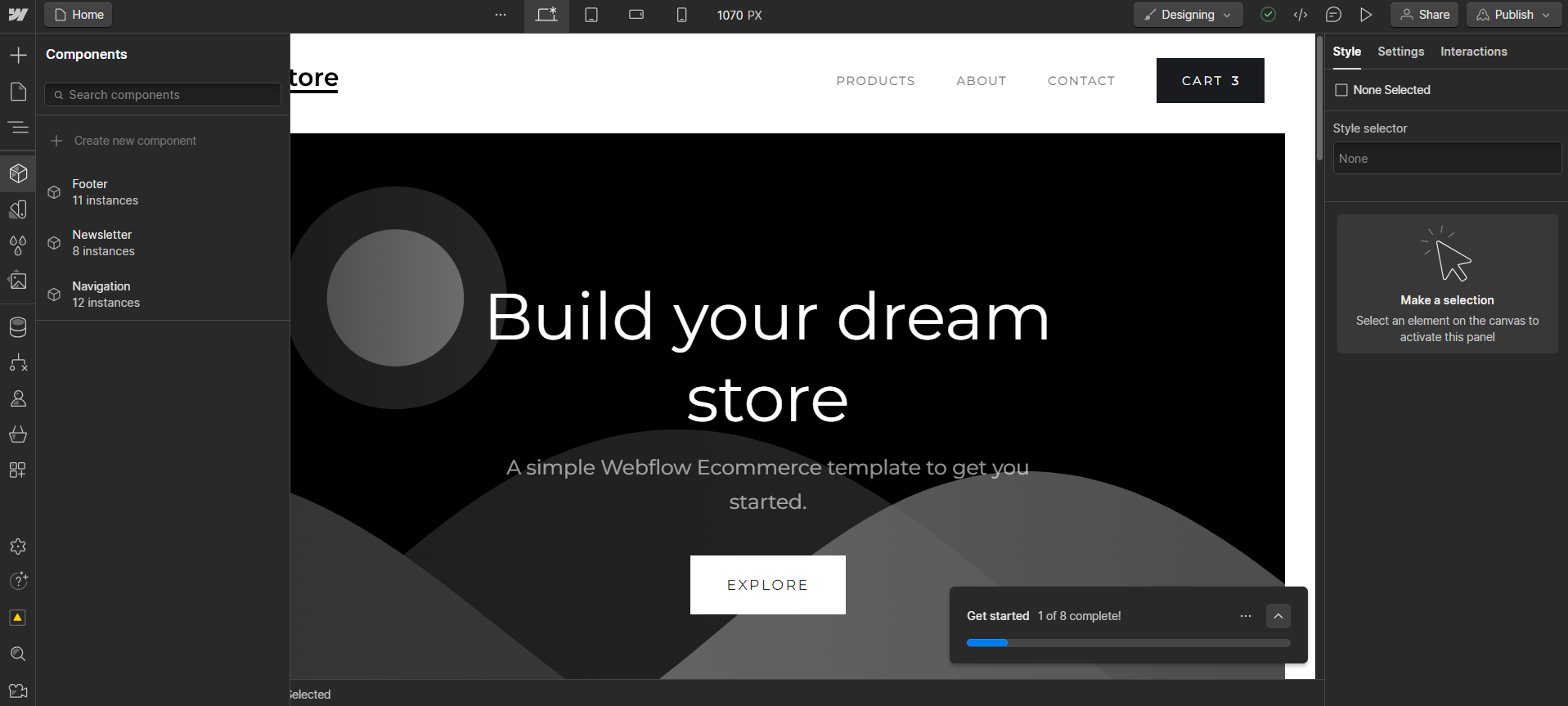
Adobe Commerce, scoring 7.8, offers a user-friendly website editor with its Page Builder tool, designed for ease of use through drag-and-drop capabilities, allowing for simple management and customization of eCommerce sites without extensive developer involvement. It provides a flexible and intuitive platform for users to effortlessly design, update, and maintain their online stores, supported by a variety of design options and themes for tailored branding and promotional activities.
Mobile editor/app
 7.0
7.0
 0
0
🏆
Winner: Webflow
. Both Webflow and Adobe Commerce(ex Magento) do not have an official mobile editor app. However, Webflow has a third-party app called EditFlow, created by a community member for Webflow users, which is currently only available for iOS. On the other hand, Adobe Commerce does not offer a mobile app for website editing at this time. Therefore, Webflow is the winner in this category due to the availability of a third-party mobile editing app.
Product testing options
Product Testing OptionsAssesses the options for trying out platform features before commitment.Score Components:
- Trial quality (40%): Extent and usefulness of the trial or free version.
- Feature accessibility (30%): How many features are available to test.
- Trial duration (20%): Length of the trial period.
- Ease of transition (10%): Smoothness of moving from trial to paid plans.
 6.3
6.3
 3.9
3.9
Overall Result
:
Webflow Wins
. Webflow scores 6.3 in product testing options, while Adobe Commerce(ex Magento) scores 3.9. Webflow offers a free version where users can test some basic features. However, it does not provide a trial version or a money-back guarantee. On the other hand, Adobe Commerce(ex Magento) does not offer a free or trial version, but it allows users to test premium features by requesting a demo version. Unfortunately, it does not provide a money-back guarantee.

|

|
|
|---|---|---|
|
Free Plan |
Yes |
No |
|
Trial Duration |
No | No |
|
Testing Premium Features |
Basic features with free plan |
By requesting a demo version |
|
Money Back Guarantee |
No | No |
Price
PriceLooks at the cost-effectiveness and value for money of each platform.Score Components:
- Plan value (40%): What each pricing tier offers.
- Transparency and clarity (30%): Clearness of pricing structures.
- Flexibility of plans (20%): Range of options to suit different budgets.
- Hidden costs (10%): Additional expenses not included in the plan.
 8.0
8.0
 5.8
5.8
Webflow offers a range of pricing options, from free to enterprise-level, while Adobe Commerce (ex Magento) is more focused on providing tailored solutions for larger businesses, starting at a higher price point.

|

|
|
|---|---|---|
|
Free |
Starter (Free): Limited features for new sites, including 2 static pages and 50 form submissions lifetime. |
No offering at this amount. |
|
$10-$20 |
Basic ($18/month): Suitable for simple sites with a custom domain, including basic SEO controls and 500 monthly form submissions. And 100 pages. Value for price: 6.5 |
No offering at this amount. |
|
$20-$30 |
CMS ($29/month): For content-driven sites with 2,000 CMS items, 1,000 monthly form submissions, and full API access. And 150 website pages. Value for price: 7.5 |
No offering at this amount. |
|
$40-$45 |
Standard ($42/month): For new businesses with up to 500 ecommerce items, includes basic ecommerce features, and 2% transaction fee Value for price: 8.5 |
No offering at this amount. |
|
$45-$50 |
Business ($49/month): High traffic capacity, advanced features like site search, and up to 10 content editors. Value for price: 8.0 |
No offering at this amount. |
|
$80-$90 |
Plus ($84/month): Higher volume businesses with 0% transaction fees, up to 5,000 ecommerce items, and advanced features. Value for price: 9.0 |
No offering at this amount. |
|
$200-$300 |
Advanced ($235/month): Scalable solution for large online stores with up to 15,000 ecommerce items and the highest caps and 0% transaction fees. Value for Price: 9.5 |
No offering at this amount. |
|
$2000+ |
No offering at this amount. |
Adobe Commerce Pro and Managed Services ($2000/month): Adobe Commerce Pro and Managed Services are designed to deliver scalable, secure, and extensive eCommerce solutions tailored to a wide range of business demands. It offers a comprehensive set of ecommerce tools, including product and inventory management, efficient order processing, customer account management, targeted marketing capabilities, diverse payment processing options, robust security measures, and scalability to accommodate business growth. It also offers both self-hosted and cloud-hosted options, providing flexibility and optimized performance. While it does not have an AI website builder, it offers a powerful theme framework for comprehensive control, including frontend editing for basic adjustments. Experienced developers can employ custom code for unique designs and advanced functionalities. |
location. As a result in rare cases the prices displayed here can differ from the ones you see on their
websites.
Hosting quality
Hosting
qualityExamines the reliability and performance of the hosting solutions.Score Components:
- Uptime (40%): Consistency and reliability of website availability.
- Speed (30%): Loading times and performance.
- Bandwidth and storage (20%): Sufficiency of resources provided.
- Data centers (10%): Quality and distribution of hosting infrastructure.
 8.9
8.9
 8.1
8.1
Winner: Webflow
. Webflow offers managed hosting with a 99.99% uptime guarantee on their Enterprise plan. They leverage a globally distributed network of data centers from Amazon Web Services (AWS) and Fastly. Adobe Commerce, on the other hand, offers both self-hosted and managed hosting options, with an uptime guarantee for their managed hosting. They leverage Amazon Web Services (AWS) for their cloud infrastructure, but specific data center details are not publicly available.

|

|
|
|---|---|---|
|
Do they offer hosting? |
Yes, included in all paid plans |
Yes, included in all paid plans |
|
Data Centers: |
Webflow doesn’t actually have its own data centers. Instead, it relies on a globally distributed network of data centers from Amazon Web Services (AWS) and Fastly. |
Adobe Commerce on Cloud infrastructure Leverages Amazon Web Services (AWS), Specific data center details not publicly available |
|
Type of hosting: |
Managed Hosting |
Self Hosting, Managed Hosting |
|
Uptime: |
99.99% |
Uptime Guarantee for Adobe Managed hosting is provided |
|
Uptime Guarantee: |
Only Enterprise plan, 99.99% |
Yes |
Website Speed Optimization
Website Speed OptimizationEvaluates optimization of website loading timesScore Components:
- PageSpeed Score (30%): Google’s score indicating performance optimization.
- Loading Time (30%): The average time until a website is fully interactive.
- Mobile Optimization (15%): Optimization effectiveness for mobile devices.
- Resource Optimization (15%): Optimizing images, scripts, and other heavy resources.
- CDN Usage (10%): Use of CDN to enhance speed across geolocations.
 8.1
8.1
 6.6
6.6
🏆 Winner: Webflow
Both Webflow and Adobe Commerce(ex Magento) prioritize website performance and page speed, but Webflow takes the lead with its custom cache settings, custom element lazy loading, automatic minification, responsive templates, and CDN.

|

|
|
|---|---|---|
|
Focus |
Custom Cache Settings, Custom Element Lazy Loading, Automatic Minification, Responsive templates, CDN |
CDN, Database optimization, Caching, Indexing |
|
Performance Tools |
Google Lighthouse, PageSpeed Insights |
Google PageSpeed Insights Integration |
|
Key Strategies |
Custom Cache Settings, Custom Element Lazy Loading, Automatic Minification, Responsive templates, CDN |
CDN, Database optimization, Caching, Indexing |
|
Load Times |
Below 2 seconds average |
Varies widely, dependent on optimization |
|
Page Speed Scores Range |
77.2/100 |
Scores vary; influenced by plugins, images |
|
Core Web Vitals Improvement |
Improving components’ usability, and emphasis on LCP, FID and CLS |
Emphasis on LCP, FID, CLS improvements |
Webflow’s approach to enhancing site speed includes custom cache settings, custom element lazy loading, automatic minification, responsive templates, and CDN. This approach leverages Webflow’s fast servers and CDN network to boost load speed. Webflow also focuses on improving components’ usability and places emphasis on Largest Contentful Paint (LCP), First Input Delay (FID), and Cumulative Layout Shift (CLS). The average load time for Webflow websites is below 2 seconds, and the average PageSpeed score is 77.2/100.
Adobe Commerce(ex Magento), like Webflow, places a strong emphasis on website performance and page speed. Adobe Commerce(ex Magento)’s approach to enhancing site speed includes CDN, database optimization, caching, and indexing. This approach leverages Adobe Commerce(ex Magento)’s fast servers and CDN network to boost load speed. Adobe Commerce(ex Magento) also places emphasis on Largest Contentful Paint (LCP), First Input Delay (FID), and Cumulative Layout Shift (CLS). However, the load times and PageSpeed scores for Adobe Commerce(ex Magento) websites vary widely, depending on optimization.
Get a head start on website creation with AI
Create a custom website tailored to your business needs 10X faster with 10Web AI Website Builder!
Plugins and integrations
Plugins and integrationsMeasures the range and effectiveness of additional plugins and integrations.Score Components:
- Variety of options (40%): Range of available add-ons.
- Integration smoothness (30%): Ease of integrating plugins into the site.
- Quality of plugins (20%): Functionality and reliability of the options.
- Custom integration capabilities (10%): Support for custom or third-party integrations.
 5.5
5.5
 9.1
9.1
🏆 Winner: Adobe Commerce(ex Magento).
Adobe Commerce(ex Magento) scores a high 9.1, offering a vast array of extensions and plugins, estimated to be in the tens of thousands, covering aspects such as marketing, payment processing, shipping, content management, security, and optimization. Webflow, scoring 5.5, doesn’t have plugins or extensions in the traditional sense. Instead, it offers a built-in library of website elements and functionalities that you can use to create your website. This library is constantly being expanded, so you’ll always have access to the latest features and tools. However, Adobe Commerce(ex Magento)’s extensive range of plugins and seamless integrations give it the upper hand.
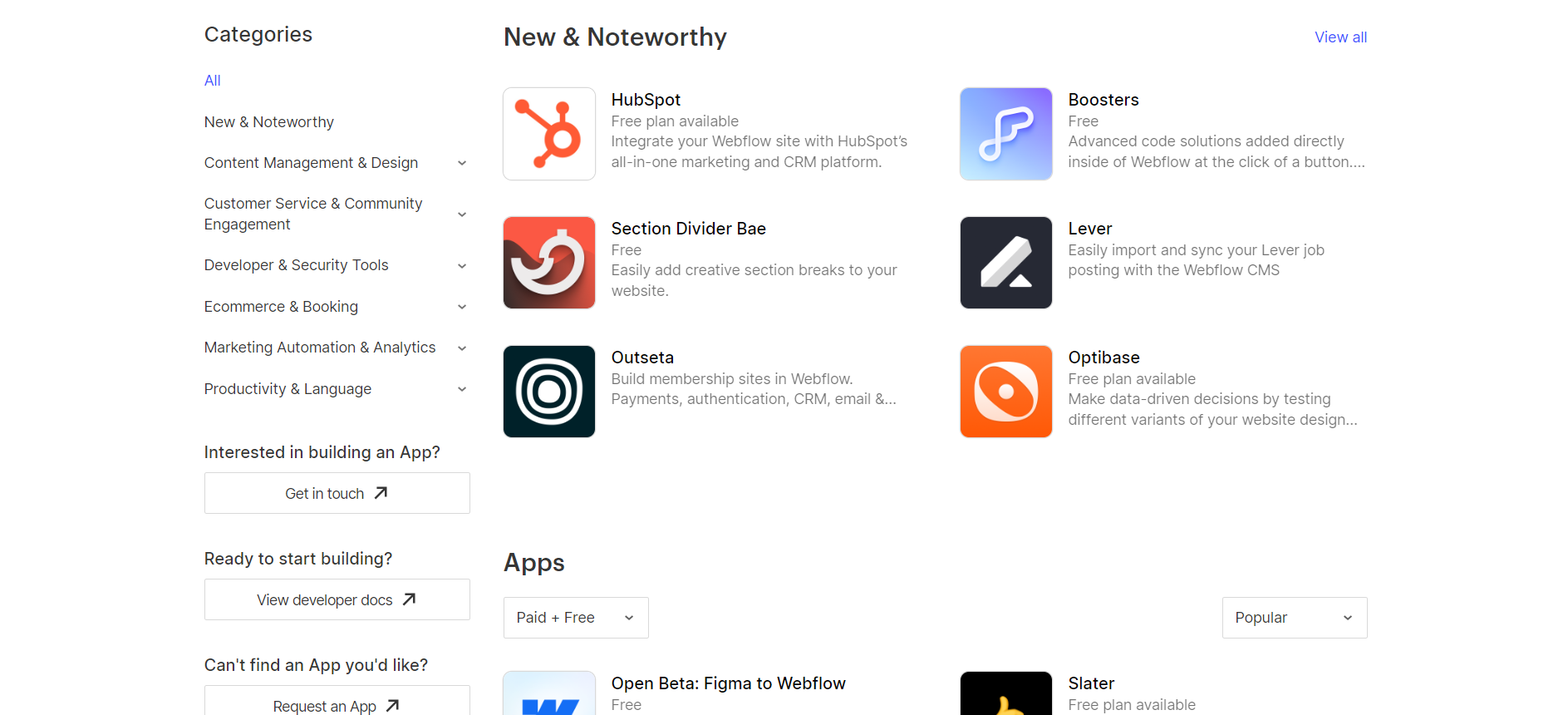
Adobe Commerce(ex Magento) Applications
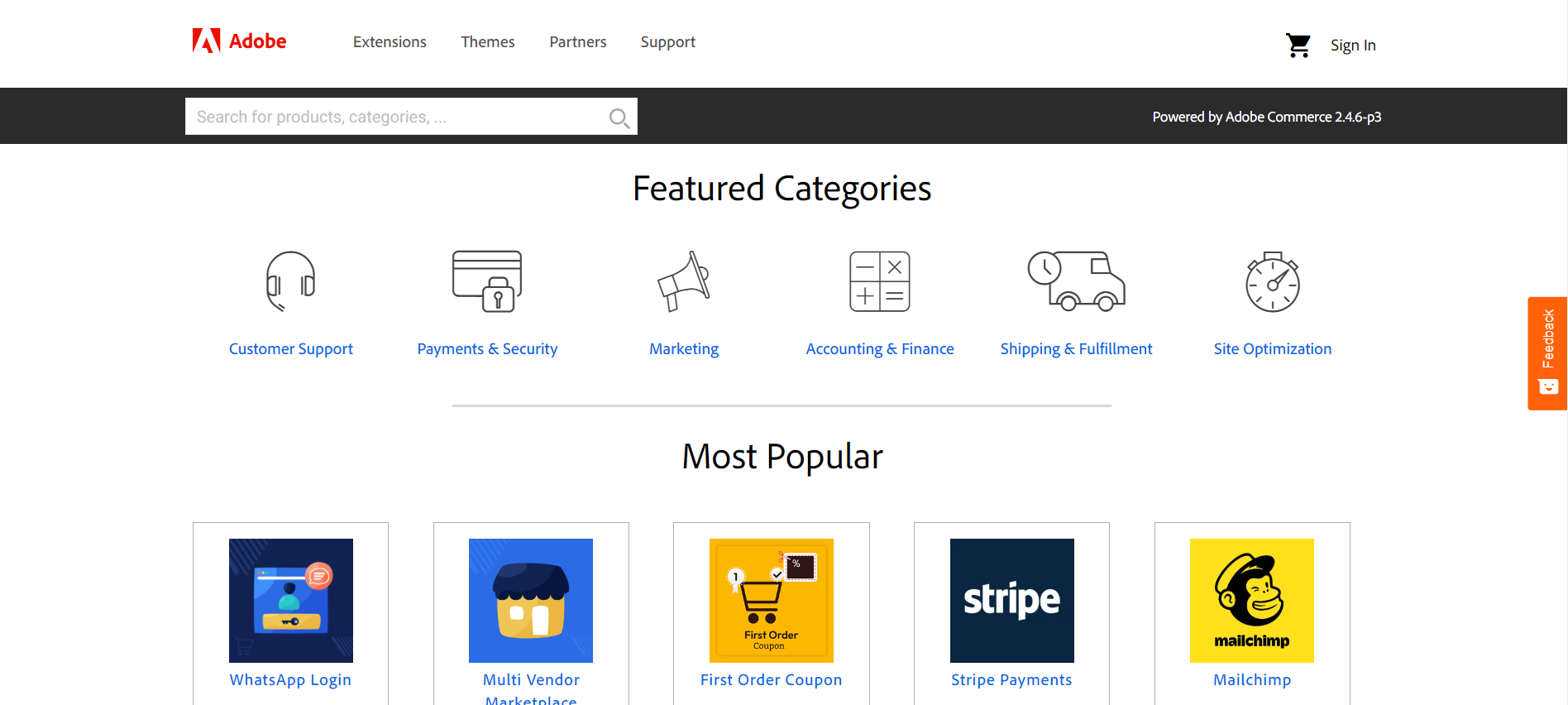
Marketing Features
Design FunctionalitiesRepresents how well each platform allows for creative design and customization of websites.Score Components:
- Template Variety (30%): Range and quality of design templates.
- Customization (30%): Flexibility and options for design alterations.
- User Interface (20%): Ease and intuitiveness of the design process.
- Responsiveness (10%): Adaptability to different devices and screen sizes.
- Innovation (10%): Unique design features and tools.
 7.8
7.8
 8.1
8.1
🏆
Overall Winner: Adobe Commerce(ex Magento)
. Adobe Commerce(ex Magento) edges out Webflow with a slightly higher score, indicating more advanced or comprehensive marketing features. Both platforms offer a range of tools, but Adobe Commerce(ex Magento) may provide more depth in areas like analytics and ad campaign management.

|

|
|
|---|---|---|
|
SEO Tools |
|
|
|
Email Marketing |
|
|
|
Blogging |
|
|
|
Social Media Integration |
Simplifies content sharing and audience engagement on major social platforms |
Yes |
|
Analytics and Reporting |
Integrates with Google Analytics for comprehensive web traffic and behavior analysis |
Adobe Commerce integrates with Google Analytics and other analytics tools, providing detailed insights into your ecommerce activities. |
|
Ads and Promotions |
Supports ad and promotion management through integration with platforms like Google Optimize |
Advanced marketing tools for creating and managing promotions, coupons, and personalized content. |
Customer Support
Customer supportEvaluates the quality and availability of support options.Score Components:
- Response time (40%): Speed of support responses.
- Support quality (30%): Effectiveness and helpfulness of the support.
- Availability (20%): Range of support channels (phone, chat, email).
- Resource richness (10%): Quality of self-help and educational materials.
 8.3
8.3
 8.3
8.3
🏆 Winner: Tie
. When comparing Webflow vs Adobe Commerce(ex Magento), both platforms offer robust customer support, each scoring 8.3. Webflow provides 24/7 support through live chat, email, and a community forum, along with extensive documentation and video tutorials. Their Enterprise plan includes a dedicated Customer Success Manager and priority support options.
Adobe Commerce(ex Magento) also offers 24/7 support via phone, email, and live chat. They provide a comprehensive knowledge base, community forums, and various support resources such as documentation and video tutorials. For enterprise users, Adobe Commerce offers dedicated account management and access to a global network of experts, ensuring businesses can maximize their ecommerce operations.
Security
SecurityLooks at the platforms’ security measures and data protection.Score Components:
- Data protection (40%): Safeguards for user and customer data.
- SSL and encryption (30%): Implementation of secure connections.
- Compliance (20%): Adherence to industry security standards.
- Regular updates (10%): Frequency of security updates and patches.
 7.8
7.8
 8.4
8.4
🏆
Winner: Adobe Commerce(ex Magento)
. Adobe Commerce (formerly known as Magento) takes website security seriously and offers a range of measures to protect online stores from potential threats. This includes regular security updates and patches to address any vulnerabilities. The platform also offers secure payment processing and encryption to protect customer data. Additionally, Adobe Commerce provides tools for monitoring and detecting any suspicious activity on the website.
Webflow, on the other hand, also ensures the privacy and security of user data by implementing robust encryption techniques and strict access controls. They also regularly update their systems and conduct audits to identify and address any potential vulnerabilities, ensuring that user information remains confidential and protected. However, based on the security score, Adobe Commerce(ex Magento) has a slight edge over Webflow in terms of security.
AI Capabilities
AI capabilitiesMeasures the effectiveness of AI-driven features and tools.Score Components:
- Automation efficiency (40%): Impact of AI on streamlining processes.
- Personalization (30%): AI-driven customization for users or customers.
- AI-Assisted design (20%): Role of AI in website design and functionality.
- Data analysis (10%): Use of AI in interpreting user data and analytics.
 8.3
8.3
 7.7
7.7

|

|
|
|---|---|---|
|
AI Builder |
Not available yet, but announced for future release |
Not available |
|
AI Ecommerce features |
Not available |
Personalized product recommendations, visual search capabilities, inventory management, and price optimization |
|
AI content generation |
Not available yet, but announced for future release |
Automated generation of unique and compelling product descriptions, SEO optimization |
|
Additional AI features |
Not available yet, but announced for future release |
AI-powered chatbots, security features, and marketing automation |
🏆 Winner: Adobe Commerce(ex Magento)
. Adobe Commerce integrates AI across various aspects of eCommerce, enhancing customer service, security, and marketing. It also uses AI to streamline content creation and optimization for eCommerce platforms. On the other hand, Webflow does not currently have AI capabilities, but they have announced plans to introduce AI features in the future.
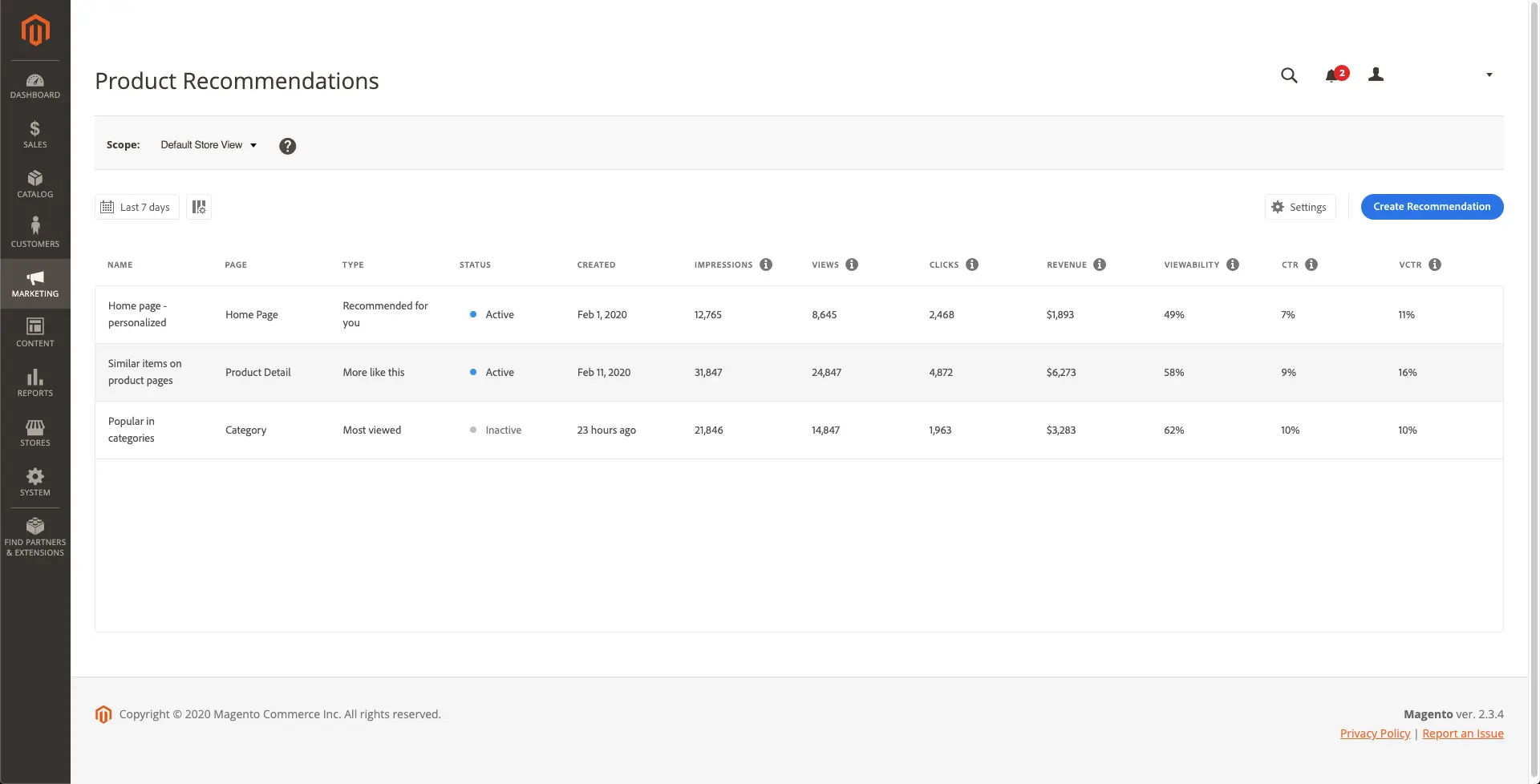
User Management
User ManagementAssesses the platforms’ capabilities in managing user roles, permissions, and accessibility.Score Components:
- Role Customization (40%): Flexibility in creating and defining user roles and
permissions. - Ease of Management (30%): User interface and tools for managing users.
- Access Control (20%): Effectiveness of access control measures for different user
levels. - Scalability (10%): Ability to manage a growing number of users efficiently.
 8.3
8.3
 8.0
8.0
🏆 Winner: Webflow
. Both Webflow and Adobe Commerce (ex Magento) offer robust user management capabilities, but Webflow edges out slightly with a score of 8.3 against Adobe Commerce’s 8.0.
- Webflow’s user management varies by plan, with Core, Growth, and Enterprise plans offering unlimited editors. Access levels include Designer for full access and Editor for content editing. Workspace roles like Admin, Designer, and Editor ensure collaboration and security.
- Adobe Commerce’s user management depends on user licenses and roles. User licenses, bought separately, determine the total number of users allowed. Roles and permissions, managed within the available licenses, control access and modifications.
Webflow User Roles and Access Levels:
| Role | Description | Access Highlights |
|---|---|---|
| Workspace Owner | Full control over Workspace settings and member management. | Edit settings, manage billing, access/edit all sites, invite/remove members, manage permissions. |
| Workspace Admin | Similar to the owner with some restrictions. | Edit settings, manage billing, access/edit all sites, invite/remove members (except owner), manage permissions. |
| Workspace Member | Limited control focused on site interaction. | Download invoices, access/edit sites, invite members. |
| Workspace Guest | Temporary collaborators with limited access. | Access/edit sites. |
| Workspace Commenter | Limited to commenting for feedback on sites. | Create/view/resolve comments, preview sites. |
| Site Admin | Full control at the site level. | Manage permissions, delete/transfer sites, billing management, design and publish changes. |
| Can Design | Design capabilities with some restrictions on publishing. | Design in Designer, create/modify classes and components, publish changes with permission. |
| Can Design (Limited) | Restricted design capabilities for Enterprise customers. | Create new classes, modify created classes, limited publishing capabilities. |
| Can Edit | Content editing without full design privileges. | Edit text/links/images, manage assets, publish Collection items and Ecommerce products. |
| Can Comment (Site Level) | Commenting for feedback at the site level. | Create/view/resolve comments, preview sites. |
Adobe Commerce (ex Magento) User Roles and Access Levels:
| Role | Description | Access Highlights |
|---|---|---|
| Administrator | Has full permissions to all aspects of Adobe Commerce, including global settings and data. | Full access to all settings, data, and functionalities within Adobe Commerce. Can manage other users’ roles and permissions. |
| Store Administrator | Responsible for the day-to-day management of the store, including products, orders, and customer service. | Access to manage products, process orders, and handle customer inquiries, but may have restricted access to sensitive global settings or data. |
| Design Team Member | Focuses on the aesthetic and user experience aspects of the store, working on content design and layout. | Access to content design tools and functionalities, but restricted from accessing customer, order information, and other sensitive areas. |
| Default User (B2B) | Has view-only access to company profile and credit information, and full access to activities related to sales and quotes. | Full access to sales and quotes activities; view-only for company profile and credit information. |
| Senior Buyer (B2B) | Engaged in purchasing, with access to all Sales and Quotes resources, and view-only permissions to the Company Profile, User and Teams, Payment Information, and Company Credit. | Comprehensive access to Sales and Quotes, with limited viewing rights for company’s financial and profile data. |
| Assistant Buyer (B2B) | Assists in purchasing activities, with permissions to place orders using Checkout with Quote, and to view orders, quotes, and company profile information. | Permission to execute orders and access relevant purchasing data; view-only access to company profile information. |
Additional Features

|

|
|
|---|---|---|
|
SSL Certificate |
|
|
|
Custom Domain |
|
|
|
Free Custom Domain Included |
|
|
|
International Domains |
|
|
|
Mobile Responsive |
|
|
|
Page Speed |
|
|
|
Website Builder Mobile App |
|
|
|
Convert a Website To An App |
|
|
|
Website Analytics |
|
|
|
Multilingual Sites |
|
|
|
Multiple Users |
|
|
User Feedback
Webflow receives high praise for its user-friendly interface, eliminating the need for coding while offering extensive design flexibility. Users appreciate its scalability, cost-effectiveness, and seamless integration of essential features like forms and CMS. However, some users note a slight learning curve and occasional limitations, particularly in ecommerce functionalities and content management. Overall, Webflow proves to be a powerful tool for building and managing websites, offering robust features for both beginners and experienced developers, albeit with some room for improvement in certain areas like collaborative editing and content management.
Adobe Commerce (formerly Magento Commerce) receives high praise for its comprehensive ecommerce solutions, offering features like customer and order management, scalability, and customization options. Users appreciate its flexibility and ease of use, although some mention a learning curve due to its extensive features. Despite occasional drawbacks like slow speed or complexity, Adobe Commerce proves beneficial for businesses seeking robust ecommerce platforms, aiding in sales growth, customer management, and overall efficiency in managing online stores.
The making of this blog
We followed a clear, step-by-step process to write and research this article.
FAQ
Which platform is better for ecommerce, Webflow or Adobe Commerce (ex Magento)?
Can I use Webflow for creating informational and business websites?
How do Webflow and Adobe Commerce (ex Magento) compare in terms of design functionalities and templates?
Which platform offers better ease of use, Webflow or Adobe Commerce (ex Magento)?
Are there any significant differences in the pricing options between Webflow and Adobe Commerce (ex Magento)?
Which platform has better hosting quality, Webflow or Adobe Commerce (ex Magento)?
How do Webflow and Adobe Commerce (ex Magento) compare in terms of website speed optimization?
Which platform offers more plugins/extensions and integrations, Webflow or Adobe Commerce (ex Magento)?
Can I manage multiple users and roles on both Webflow and Adobe Commerce (ex Magento)?
Which platform is recommended based on user feedback for building and managing websites?










